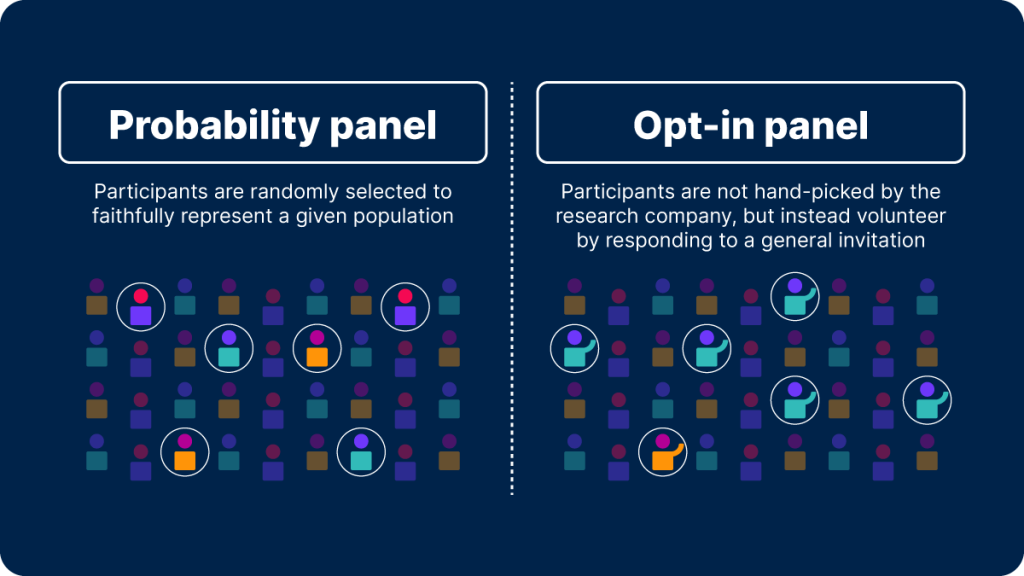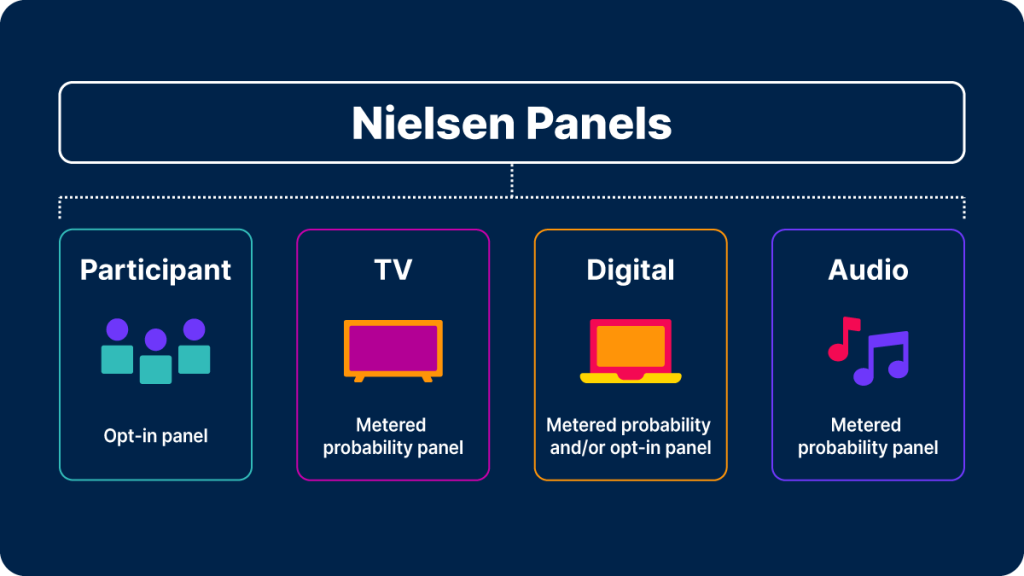I panel e i dati che generano sono stati il gold standard del settore della ricerca per quasi un secolo e rimangono lo strumento più accurato per misurare l'audience dei media.
Seguiteci mentre analizziamo i dati dei panel: Cosa sono, perché sono importanti e dove stanno andando.
Cos'è esattamente un panel?
Nella ricerca sui media, un panel è semplicemente un gruppo di famiglie o di individui che hanno accettato di condividere i propri dati personali e di partecipare a studi regolari o a misurazioni continue del loro utilizzo dei media per un determinato periodo di tempo.
Ma non tutti i panel sono uguali. Esistono due tipi principali:

Panel probabilistici
I partecipanti ai panel probabilistici sono selezionati in modo da rappresentare fedelmente una determinata popolazione (come un'audience televisiva nazionale o un mercato radiofonico locale). La società di ricerca si preoccupa di gestire il processo di reclutamento e di mantenere l'integrità statistica del panel nel tempo. Ciò significa reclutare i panelisti, registrare senza indugio nuovi dispositivi, tenere conto dei cambiamenti nelle dimensioni e nella composizione delle famiglie e garantire che i dati riflettano accuratamente ciò che le persone fanno. I panel televisivi e audio di Nielsen sono panel probabilistici.
Panel Opt-in (convenience)
I partecipanti ai panel opt-in si offrono volontari rispondendo a un invito generale di una società di ricerca. Poiché potrebbero rispondere all'invito solo alcuni tipi di persone, i panel opt-in non sono rappresentativi di una determinata popolazione. Tuttavia, sono estremamente utili per la misurazione dell'audience. Sono utili per comprendere le distorsioni dell'identità, vengono utilizzati come input di calibrazione per mettere a punto i modelli e possono convalidare e correggere le informazioni di terza parte provenienti da partner di big data. In Nielsen, i panelisti opt-in non sono sempre attivamente misurati, ma utilizziamo il nostro ampio panel opt-in per convalidare le informazioni di terza parte provenienti da partner di big data.
I dati dei panel di probabilità, combinati con i dati del censimento che parlano del reddito, dell'età e della composizione di una famiglia, forniscono un'analisi statisticamente accurata di chi consuma i media.
Insieme, i panel di probabilità e opt-in possono fornire informazioni dirette sul consumo dei media, calibrare ed eliminare le distorsioni dei dati a livello di censimento e garantire un'analisi più accurata del coinvolgimento del pubblico su diversi dispositivi.
A cosa si iscrivono i partecipanti al panel?
Alcuni panel richiedono una partecipazione attiva piuttosto che passiva. Ai panelisti può essere chiesto di compilare sondaggi regolari, di premere un pulsante per verificare che stiano guardando la TV o di indossare un dispositivo per catturare le attività fuori casa, come ascoltare la radio in auto o guardare lo sport in un bar. Altri panel non richiedono alcun impegno, se non quello di autorizzare la società di ricerca a installare un componente hardware o un software (noto come "meter") per registrare l'utilizzo dei media dietro le quinte: quali programmi televisivi stanno guardando, per esempio, o quali podcast, siti web o app stanno utilizzando.
La partecipazione attiva, rispetto alla misurazione automatizzata, è spesso necessaria per acquisire i dati più precisi a livello personale e massimizzarne il valore. Per mantenere alto il livello di collaborazione del panelista, critico per un'elevata qualità dei dati, le società di ricerca serie investono molto nell'esperienza del panelista per eliminare gli attriti in ogni fase del processo.
Nielsen ha quattro tipi diversi di panel:

- TV - Un panel probabilistico che misura il chi, il cosa, il come e il dove dell'audience televisiva e dello streaming
- Audio - Un panel probabilistico che misura il consumo audio in-home e out-of-home a livello locale e nazionale e che comprende sia mercati misurati con un meter che mercati monitorati con panelisti che scrivono un diario dei loro consumi sui media.
- Digitale - A seconda del mercato, un panel probabilistico misurato e/o opt-in che misura l'esposizione agli annunci e ai contenuti per computer, mobile e su tutte le piattaforme
- Partecipante - Un panel opt-in di panelisti registrati, non misurati con meter, per migliorare i nostri asset di panel meterizzati con funzionalità come la calibrazione dei big data e la convalida dell'identità.
Come vengono utilizzati i panel multimediali?
Mentre i dati dei panel possono essere utilizzati da società di ricerca che monitorano le tendenze di consumo o da agenzie governative che cercano di monitorare le abitudini di consumo della popolazione, i dati dei panel media sono più spesso utilizzati da società di media, marchi e inserzionisti che cercano di capire la visualizzazione dei contenuti e la portata e la frequenza delle campagne pubblicitarie.
Per i network, gli editori e gli altri venditori di media, i dati dei panel sono utili a conoscere le dimensioni, le abitudini e le tendenze del loro pubblico, che vengono poi utilizzate per definire le strategie di programmazione, tariffazione e distribuzione dei contenuti.
Per i marchi, gli inserzionisti e gli altri acquirenti di media, i dati dei panel vengono utilizzati per capire chi sta effettivamente vedendo i loro annunci, quali piattaforme preferisce il loro pubblico target e prevedere come questi comportamenti possano cambiare nel tempo.
I panel sono obsoleti nell'era dei big data?
Forse starete pensando: abbiamo bisogno di panel ora che disponiamo di grandi dati provenienti da set-top box, smart TV, piattaforme di streaming, canali di social media, reti di media retail e tutto ciò che sta in mezzo?
È un'idea sbagliata molto diffusa.
Innanzitutto, i big data (come i dati di riconoscimento automatico dei contenuti {ACR} dalle smart TV) possono dirci cosa viene trasmesso sullo schermo, ma non chi lo sta guardando o quanti amici e familiari potrebbero essere seduti sul divano a guardare. In effetti, è impossibile capire dai soli big data se un programma o un film viene trasmesso in una stanza vuota. Nessuno vuole pagare per i media senza pubblico.
Inoltre, i big data non sono rappresentativi dell'intero pubblico dei media. L'unico modo in cui potrebbero esserlo è se tutti utilizzassero la stessa tecnologia e avessero accesso agli stessi contenuti. Una società via cavo può avere decine di milioni di abbonati, ma questi spettatori non pagano tutti gli stessi canali o non guardano gli stessi programmi.
Senza la capacità di identificare il pubblico reale e quindi di individuare e rappresentare il profilo demografico degli spettatori, è impossibile per le società di ricerca che si affidano esclusivamente ai big data deduplicare l'audience tra le piattaforme, i dispositivi e i servizi e mettere insieme l'intera storia.
Come ottenere il meglio di entrambi i mondi?
Per essere chiari, le distorsioni dovute a problemi di campionamento o di mancata risposta possono compromettere un panel probabilistico tanto quanto un grande insieme di dati. Ma con le giuste dimensioni, la giusta attenzione ai dettagli e una conoscenza approfondita delle statistiche, un panel ben gestito è ancora il modo migliore per rappresentare la popolazione generale e fornire stime affidabili della composizione dell'audience nell'ecosistema mediatico incredibilmente diversificato di oggi.
Quindi, i big data sono del tutto inutili? Certo che no! Le loro dimensioni consentono di analizzare l'utilizzo dei media con molta granularità e, con la giusta calibrazione e la modellazione basata sulle persone, i big data possono offrire intuizioni preziose per la programmazione della "coda lunga" e per i pubblici difficili da raggiungere.
Diverse organizzazioni, tra cui la World Federation of Advertisers, ritengono che la combinazione di panel e big data sia il vero futuro della misurazione dell'audience e molte società di ricerca stanno lavorando duramente per sviluppare queste capacità.
Nielsen Bisogno di sapere passa in rassegna i fondamenti della misurazione dell'audience e demistifica gli argomenti più scottanti del settore dei media. Leggete ogni articolo qui.
Nota
1. Due primi esempi degni di nota sono stati il National Consumer Panel, lanciato da Samuel Barton nel 1942 nell'ambito dell'iniziativa dell'Office of Price Administration di Roosevelt per misurare il consumo domestico dei beni razionati durante la Seconda Guerra Mondiale; e il panel alla base del Nielsen Radio Index, lanciato nello stesso anno da Arthur C. Nielsen per rilevare l'attività di accensione e spegnimento della radio e la sintonizzazione dei canali utilizzando un ingegnoso dispositivo meccanico sviluppato per la prima volta al MIT: l'Audimeter.



